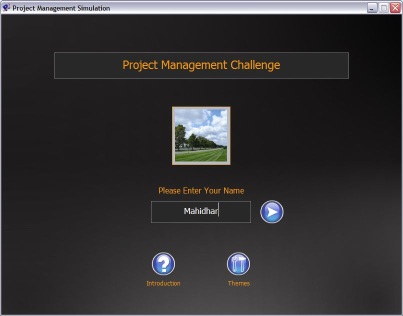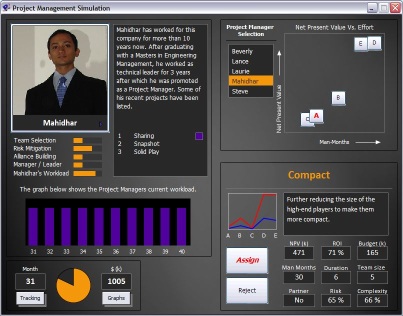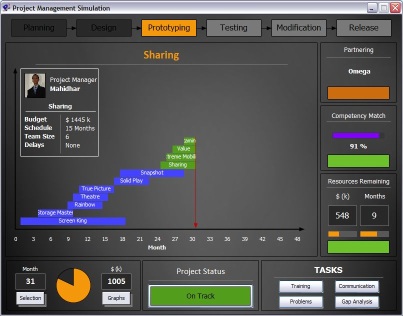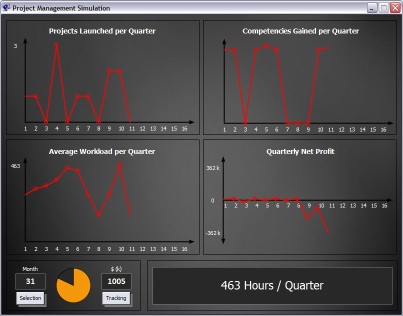Being a mechanical engineer, coding was never a skill that I could boast about even though I have always been computer savvy and have been able to handle tasks such as reinstalling windows, troubleshooting drivers and installing new hardware all by myself! I'd find an excuse to get away when my computer graduate friends would start discussing about loops, arrays and data structures. Somehow, I could never picture myself sitting in front of a computer and writing code on C++ while singing along to the tunes of Metallica and R.E.M!
All that changed last year towards the end of December when my professor, Dr. Schumacher and I started working on a Project Management simulation.

The first question that I had for my professor was whether I would have to be an expert at computer programming to work on this simulation, since programming like I mentioned, was never my cup of tea. That's when he introduced me to Runtime Revolution. The first thing that caught my attention and stunned me was the English-like scripting language. Never before had I seen a program that was so intuitive and simple to grasp. I was writing simple programs within a few hours of starting! The feature I admire most in Revolution is the ability to create quick prototypes and test them immediately, without the need to create an executable file. Even though my professor uses a Mac and I use Windows, sharing stacks was easy and painless.

When we finished designing the overall concept and the high-level design for the simulation, my professor passed on a stack that he had started working on that week. I always shuddered at the thought of going through hundreds of lines of computer code, trying to find one bug that was causing the program to malfunction or work incorrectly! With Revolution though, the story was completely different – the biggest advantage was probably the simplicity of the scripting language. Three months later, I was writing complex code to create and generate graphs, pie charts, small animations and effects to create visual eye-candy! I now have a program with a little over 3,900 lines of code – I'm confident that in these five months, I have written more lines of code than I have in my entire life!
The ability to use variable on the fly, import tables created in excel and import high-quality images are features in Revolution that I appreciate the most. My programming task
has become so much simpler because of the way Revolution handles variables – variables can be decla "on the fly" and can be used to store strings, numbers,
characters
and even arrays! Making this feature even better is the fact that the variable type needn't be declared before use. I remember from my introductory computer courses that I had to declare variables in traditional programming languages and pay attention to the size of an array – Revolution on the other hand, handles these nuances and lets the user concentrate on the most important task – writing a good quality programs.

Since my simulation uses a lot of numerical data to create graphs, charts and reports, I was looking for ways to import data into the program. I discovered an import feature that lets users import tab separated data from text files and this is another feature that I have used extensively. Although there might be a simpler way to do this, the approach that I'm going to mention is simple enough. The first step in the process is to save the excel data as a text file (tab delimited). Sometimes, when the data contains strings or lines of text, excel automatically houses them in quotes. To avoid revolution from importing these quotes, a search and replace technique in notepad can be used by replacing the <''> with < >. The last step in the process is to import this text file in Revolution by creating a field or a table and using the import feature (folder icon) on the contents section of the object inspector. However big or complex the text file, Revolution has no problem importing it!

The project management simulation that I'm creating with my professor teaches the player to manage projects strategically and other aspects such as stakeholder and risk
management, team selection and development, coaching and alliance formation. The simulation takes the player through two different games: the first game focuses on maximizing the financial return, sometimes even ignoring the other aspects mentioned above. The second game on the other hand, focuses on activities for short-term and long-term gain for the organization. The “paired game” design developed by Dr. Schumacher shows the player a stark contrast by presenting the player with two different frames of references and helps him appreciate the advantages of strategically managing projects.
As I sit in my single-room, spewing out a hundred lines of code every day, I can't help but wonder how many of my friends would benefit if their companies or schools switched
to
Revolution, instead of sticking to C/C++. I'm overjoyed that I was introduced to Runtime Revolution for a task as complex as this. After all, how many mechanical engineers without any previous experience in writing code, can boast about writing a program with over 3900 lines of code on their first coding attempt? Thanks to Revolution, I now can! |



